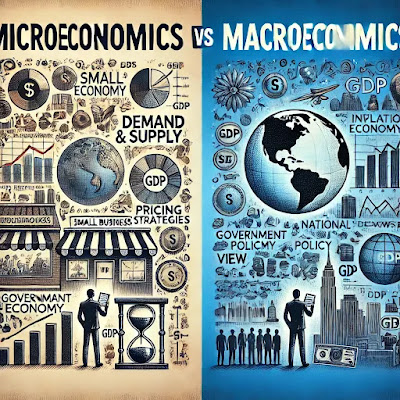📊 Micro vs. Macro Economics: Understanding the Key Differences
Economics is a vast subject that helps us understand how resources are allocated, how markets function, and how economies grow. It is broadly divided into two major branches: Microeconomics and Macroeconomics.
While both study economic behavior, they focus on different aspects. In this article, we will explore the differences between micro and macroeconomics and their real-world applications.
What is Microeconomics?
Microeconomics is the study of individual units within an economy, such as consumers, businesses, and industries. It examines how they make decisions, allocate resources, and interact in markets.
Key Areas of Microeconomics:
Example of Microeconomics in Action:
- A coffee shop deciding the price of a cappuccino based on customer demand and production costs.
- A mobile phone company adjusting its prices to compete with rivals.
What is Macroeconomics?
Macroeconomics, on the other hand, focuses on the economy as a whole. It studies large-scale economic factors such as inflation, unemployment, national income, and government policies.
Key Areas of Macroeconomics:
Example of Macroeconomics in Action:
- The government reducing taxes to boost economic growth.
- The central bank increasing interest rates to control inflation.
Micro vs. Macro Economics: Key Differences
| Aspect | Microeconomics | Macroeconomics |
|---|---|---|
| Scope | Focuses on individual agents (households, firms) | Focuses on the economy as a whole (national/global scale) |
| Level of Study | Small-scale (individual or firm) | Large-scale (nation/global) |
| Primary Concern | Supply and demand of specific goods/services | Overall economic indicators (GDP, inflation, etc.) |
| Objective | Understand decision-making at the micro level | Analyze broader economic phenomena |
| Focus on Prices | Examines how individual prices are set in markets | Studies aggregate prices and inflation |
| Key Variables | Price, quantity, consumer preferences | National income, unemployment rates, inflation |
| Examples | Labor market, product markets, competition | National output, economic growth, government policies |
| Policy Application | Guides business strategy and pricing | Guides government fiscal and monetary policies |
| Methodology | Marginal analysis and agent behavior | Aggregate data and macroeconomic models |
| Time Frame | Short-term focus on specific sectors or industries | Long-term focus on overall economic performance |
How Micro & Macro Economics Are Connected
Though micro and macroeconomics have different focuses, they are interconnected. For example, when inflation (a macroeconomic factor) rises, individual businesses (microeconomic units) may increase product prices to maintain profits. Similarly, government policies (macro) influence consumer spending (micro).
Conclusion
Understanding both micro and macroeconomics is essential for analyzing financial markets, government policies, and business strategies. Whether you are a student, entrepreneur, or policymaker, having a strong grasp of these concepts helps you make better economic decisions.
💡 What do you think is more important—Micro or Macro Economics? Share your thoughts in the comments!
🔗 Read More: Banking Professional Exam Assistant
Micro vs. Macro Economics Quiz
1. What does microeconomics study?
2. Which is a key focus of macroeconomics?
3. Which concept is NOT part of microeconomics?
4. GDP is a key factor in which branch of economics?
5. What does microeconomics focus on?





Helpfull Post.